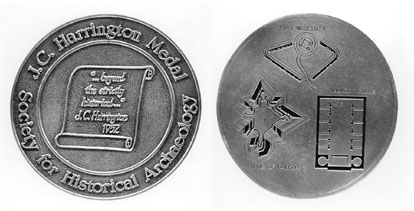

 | Page 733 |  |
In 1981, the society for historical archaeology (SHA) created the J.C. Harrington Medal, the highest award offered in the discipline. Medalists are selected for a lifetime of contributions to the field centered on scholarship. The first copy of the medal was struck in silver and was presented in January 1982 in a surprise ceremony to jean carl (pinky) harrington at the annual SHA conference in Philadelphia. All other copies are in antique bronze.

The J. C. Harrington Medal. The face bears the quotation “…beyond the strictly historical…,” from one of Harrington’s famous articles; the obverse shows the ground plans of three of the most famous sites Harrington and his wife,Virginia, excavated: Raleigh’s 1585 Fort,Washington’s 1754 Fort Necessity, and the nineteenth-century Mormon temple at Nauvoo.
(Courtesy of the University of Pennsylvania Museum of Archaeology and Anthropology)
The list of recipients below reflects in a very general way the historical evolution of the discipline. To date, all medalists have been from North America (United States and canada), the region where the field has the deepest history going back to the 1930s, although the award is worldwide in scope. The names also in a vague fashion show the history of the discipline. The list includes researchers who were based in governmental agencies, museums, or similar institutions (cotter, fontana, Harrington, hume, kidd, Quimby, South, and Woodward), transitional figures who started in such settings but spent much of their career in the academic world (Fairbanks, Jelks, and Smith), people who were always academics (Bass, deetz, Gilmore, Salwen, and Sprague), and, finally, Roberta S. Greenwood, the first archaeologist whose major contributions to scholarship were grounded in what has become
 |  |